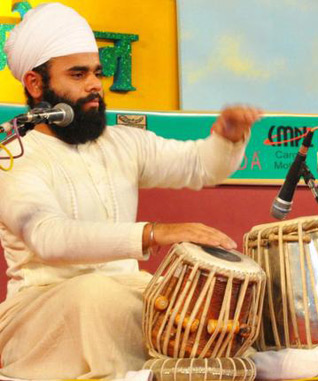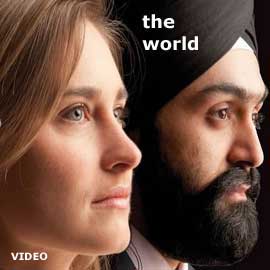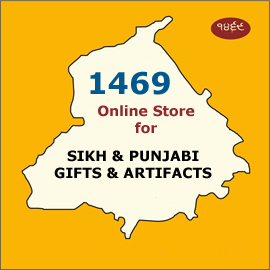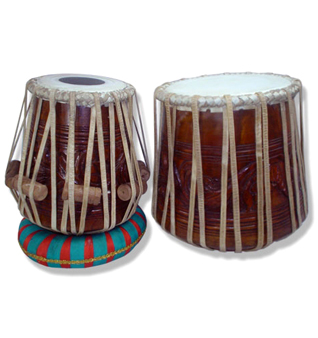Music
Sikh Classical Music:
Percussion Power
KRISHNARAJ IYENGAR
Right from its inception, Sikhism has been synonymous with music as a medium of connecting the soul with the One, the God of all creation.
Bhai Mardana, Guru Nanak’s Rabaabiya, it is believed, would musicalise the latter’s divine inspirations into soulful raags. Morever, the verses in the Guru Granth Sahib are all set to specific raags.
“Guru Nanak would often sing his response to someone who asked him a question!” smiles famed ‘kathakaar’ Morari Bapu.
Gurbaani kirtan rendered in gurdwaras embody nuances of Sikh and Punjabi classical music, the stark, Saatvik simplicity sans catchy frills, purity and overwhelming humility drive the devotee to tears.
Sikh classical music stands as a genre apart with its distinctly devotional nature. Though common raags and taals are employed, instruments such as Saranda, Taus, Dilruba (bowed instruments) and the plucked Rabaab are typical to Sikh music.
Interestingly, an ancient classical drum called the pakhawaj jorrhi is exclusive to Sikh music. Though resembling the tabla, the jorrhi is a vertical pakhawaj (ancient horizontal drum) with the left and right sides inverted as two separate vertical drums with moist flour smeared on the dhama (left hand drum) like in the pakhawaj, for a deeper tone.
Today it is the forte of the Sikh-Namdharis, Sukhwinder ‘Pinky’ Singh being among its prominent exponents.
Senior tabla maestro and scholar Pandit Arvind Mulgaonkar explains that the jorrhi was invented during the Fifth Master, Guru Arjan’s era, essentially to accompany the age-old Dhrupad style, in which kirtan was primarily rendered right from Mardana’s time.
“The jorrhi uses powerful strokes, and the technique and repertoire are similar to the pakhawaj, except that being vertical, the jorrhi offers a wider scope for speed and rhythmocity (laykaari), mathematics, complexity and expression,” says Pandit Mulgaonkar.
Originally, the pakhawaj would accompany dhrupad, but with the emergence of khyal singing, the jorrhi emerged as a softer, more refined accompaniment to dhrupad, later the tabla, to accompany khyal.
With the gradual evolution of the tabla as a solo instrument, there emerged various gharanas -- Delhi, Ajrada, Farukhabad, Lucknow and Benaras.
“While pakhawaj stalwart Lala Bhavanidas brought tabla to the fold, it was Ustad Faqir Bakhsh-I who later pioneered the Punjab gharana of tabla. After being denied the title of Khalifah or torchbearer after his teacher’s death, he quit playing the pakhawaj and took to the tabla in retaliation and there was born a sort of a synthesis of both styles,” explains Pandit Mulgaonkar.
Faqir Bakhsh-II, his descendant, rose to great prominence as a performer, teacher and composer. Many of his disciples became legends including Ustad Firoz Khan and Miyan Qadar Bakhsh-II who taught the likes of Ustad Allah Rakha, Ustad Allah Ditta and Shaukat Hussain of Pakistan.
One of Ustad Firoz Khan’s chief disciples was the legendary Pandit Gyan Prakash Ghosh (Gyan Babu) of Kolkata whose contribution to the Punjab gharana is historic. A venerated composer, his songs bore the stamp of the quintessential Punjab style. While Firoz Khan’s compositions stood as a class apart with their uniquely masculine, bold, expansive, colourful, flamboyant yet refined and poetic flavour, Gyan Babu further evolved the style with his touch of intellectualism and depth.
In the course of history, Punjab masters evolved a tabla style that incorporated the pakhawaj’s robustness reflected in bold, powerful strokes. Through the interaction of maestros of different gharanas though, an exchange of ideas influenced the Punjab style.
“My teacher Ustad Amir Hussain Khan saheb, the doyen of Farukhabad Gharana too, had an immense repertoire of Punjab through exchange of compositions with maestros such as Baba Malang Khan and Abbu Khan,” says Pandit Mulgaonkar.
Today, the Gharana is divided between the two halves of Punjab currently in India and Pakistan among past veterans Karim Bakhsh Pairna, Nabi Bakhsh, Karam Ilahi, Pawan Kumar Varma, Akhtar Husain Khan and Ustad Bahadur Singh, to name a few.
“My teacher Ustad Allah Rakha brought the tradition to Mumbai in the 1930s. Highly challenging Gat-Tukda, Paran and Chakradhar compositions are the forte of the gharana which need intense riyaaz to perfect,” says Pandit Yogesh Samsi.
[Courtesy: The Hindu Newspaper. Edited for sikhchic.com]
October 10, 2015
Conversation about this article
1: Sangat Singh (Kuala Lumpur, Malaysia), October 17, 2015, 4:02 PM.
What a breautiful description. This binds the two Punjabs, since they share a common heritage. The Sikh Rababi tradition started with Bhai Mardana and continued right up to the time of the Partition of Punjab when Rababis were still doing kirtan in Harmandir Sahib. In Lyallpur, as a growing child, I still remember the rababi tabla player intoning the 'paurris' of Asa di Vaar. Even when not singing in the Wadda Gurdwara he would be found sitting on his 'manja' in front of his house with closed eyes singing some shabad. Pity we foolishly lost that wonderful tradition with the Partition. Luckily we still have some families of rababis in Pakistan who are keeping this tradition alive. In one of the Raag Darbars I heard, one of the well known rababis started with the Gurbani lines: "Many religious texts (shaastras and smirtees) have I seen and searched through them all, none are equal to Waheguru's Name" [GGS:265.9]




